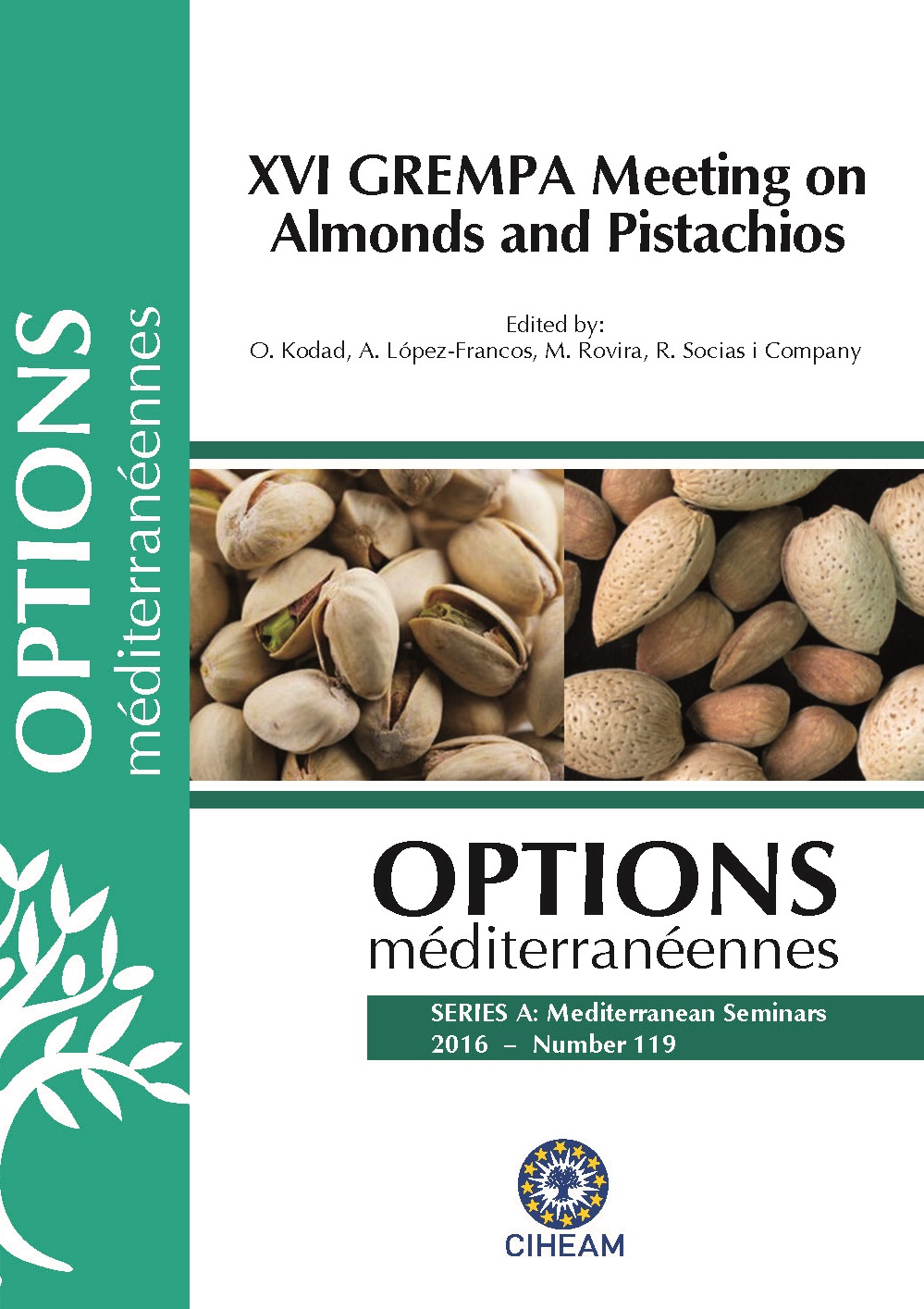| Article précédent | p. 151-154 | Article suivant |
Assessment of control pollinated progenies as almond rootstocks
In order to select almond seedling rootstocks, many trials were conducted, at the Agricultural Experimental Unity located at the north east of Tunisia, to study the value as rootstocks of open pollinated almond genotypes. More vigorous and more developed seedlings with branched root system progenies were obtained. This study aimed to assess growth characteristics of almond seedlings obtained from controlled pollination. Thus, eight local genotypes: ‘G12-2’, ‘Tozeur 3’, ‘G12-4’, ‘G24-12’, ‘G24-10’, ‘G23-15’, ‘G25-6’, ‘G25-8’ and one foreign almond variety ‘Fasciuneddu’, were used as parentages in several controlled crosses. The fruit set was followed, but only two out of seven crosses carried out yielded fruits. Seeds harvested from the two crosses and a mixture of bitter almond seeds, the most popular rootstock in Tunisian nursery, used as control, were germinated and sown in plastic bags. Plant height, stem diameter at the ground level, number of shoots and distance up to the first shoot, were determined during vegetative dormancy. Statistical analysis showed significant differences between progenies derived from cross pollination and those from bitter almond seeds. A great vegetative growth was recorded on the progenies of ‘G25-6’ x ‘G25-8’. The average plant height and stem diameter at the ground level was 103.88cm and 8.95mm respectively. Moreover, these progenies showed the higher distance up to the first shoot, which facilitate the grafting. The cross made between ‘G12-2’ and ‘Tozeur 3’ has also provided homogeneous and vigorous seedlings. So these results showed that cross pollination may be used to select almond rootstock seedlings.
Plusieurs études de la valeur comme porte-greffe de semis d’amandiers ont été menées à l’Unité d’Expérimentation Agricole située au nord est de la Tunisie. Des descendants issus de pollinisation libre très vigoureux et à système radiculaire très développé et ramifié ont été obtenus. Cette étude a pour objectif l’évaluation des caractéristiques de croissance de descendants issus de pollinisation contrôlée. Ainsi, 8 génotypes locaux: ‘G12-2’, ‘Tozeur 3’, ‘G12-4’, ‘G24-12’, ‘G24-10’, ‘G23-15’, ‘G25-6’, ‘G25-8’ et une variété introduite d’Italie ‘Fasciuneddu’ ont été utilisés comme parents pour la réalisation de 7 croisements. Le taux de nouaison a été suivi et seul deux croisements ont donné des fruits. Après stratification, le semis des amandes obtenues et d’un mélange d’amandes amères, principal porte-greffe utilisé en Tunisie pour l’amandier, a été réalisé en sachets. La hauteur, le diamètre de la tige au niveau du sol, le nombre d’anticipés et la distance d’insertion du premier anticipé ont été déterminés au cours de la dormance végétative. Des différences significatives ont été obtenues entre les descendants issus de pollinisation contrôlée et ceux issus du mélange d’amandes amères. Ceux issus du croisement ‘G25-6’ x ‘G25-8’ se sont distingués par leur grande vigueur. Leur hauteur moyenne a été de 103.88cm et le diamètre moyen au sol de la tige a été de 8.95mm. De plus, ils se sont caractérisés par la plus grande distance d’insertion du premier anticipé. Le croisement ‘G12-2’ x ’Tozeur 3’ a également fourni des descendants vigoureux et homogènes. Ces résultats montrent que la pollinisation contrôlée peut être utilisée pour la sélection de porte–greffes francs d’amandier.
- [ Afficher ]
- [ Télécharger ]
- [ Exporter la citation ]
Vous pouvez télécharger la citation au format :
- [ Imprimer ]
-
Mots-clés
CROISEMENT, POLLINISATION, PRUNUS AMYGDALUSCiter cet article
Mselmi Taoueb S., Ben Hamda H., Jraidi B., Ouerghi I., El Gharbi A. Assessment of control pollinated progenies as almond rootstocks. In : Kodad O. (ed.), López-Francos A. (ed.), Rovira M. (ed.), Socias i Company R. (ed.). XVI GREMPA Meeting on Almonds and Pistachios. Zaragoza : CIHEAM, 2016. p. 151-154. (Options Méditerranéennes : Série A. Séminaires Méditerranéens; n. 119). 16. Meeting of GREMPA (Groupe de Recherches Méditerranéennes pour l\'Amandier et Pistachier / Mediterranean Research Group for Almond and Pistachio), 2015/05/12-14, Meknes (Morocco) . http://om.ciheam.org/om/pdf/a119/00007381.pdf



